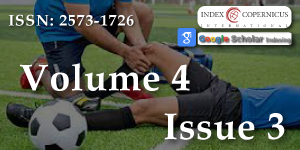Assessment of shoulder pain and somatic dysfunction in young competitive swimmers: Preventive Osteopathic Manipulative Treatment
Main Article Content
Abstract
Context: Shoulder pain is one of the most frequent reported complaints in intensive competitive swimming. The so-called ‘swimmers’ shoulder’ has been widely explored and has been reported sometimes without specific reference to contributing mechanisms or structures. Somatic dysfunction is defined as an impaired or altered function of related components of the somatic system and may appear in the early stage of pain feeling.
Aim: To evaluate somatic dysfunctions in a group of young competitive swimmers with and without shoulder pain and its relationship with the shoulder’s mobility along with the efficacy of an osteopathic manipulative treatment (OMT) on shoulder’s mobility, pain, and comfort of swimming.
Material and method: 20 competitive swimmers (14.6 ± 1.3 ys; 11.6 ± 2.4 hs.wk-1) were divided into two groups, with and without shoulder pain (SPG/CG). Before and after light touch/OMT, and 1 week later, somatic dysfunctions, shoulder’s range of mobility, pain, and swimming comfort were assessed by 2 independent osteopaths.
Results: Somatic dysfunctions were observed in both groups without significant differences in the number or localization and were independent of severity of pain. In the SPG, pain decreased significantly after OMT (6.1 ± 1.9 vs. 3.9 ± 1.8; p = 0.001) and remained stable 1-week later (P = NS). Shoulder’s mobility was lower on the aching shoulder in the “shoulder pain” group when compared to the control group on flexion and abduction tests but not on extension or adduction tests. Following OMT, only abduction improved when compared to light touch. Comfort in swimming was reported as “better” in both OMT/light touch groups.
Conclusion: There is no difference between light touch and OMT as both decreased pain and increased comfort in swimming but abduction range of motion only improved in the OMT group.
Article Details
Copyright (c) 2019 Granger F, et al.

This work is licensed under a Creative Commons Attribution-NonCommercial 4.0 International License.
https://www.nhs.uk/live-well/exercise/swimming-for-fitness/ 2019
Bak K. Nontraumatic glenohumeral instability and coracoacromial impingement in swimmers. Scand J Med Sci Sports. 1996; 6: 132-144. PubMed: https://www.ncbi.nlm.nih.gov/pubmed/8827842
Harrington S, Meisel C, Tate AA. cross sectional study examining shoulder pain and disability in division I female swimmers. J Sport Rehabil. 2014; 23: 65-75. PubMed: https://www.ncbi.nlm.nih.gov/pubmed/23945068
Bulter D, Funk L, Mackenzie TA, Herrington LC. Sorting swimmer’s shoulders: an observational study on swimmers that presented to a shoulder surgeon. Int J Shoulder Surg. 2015; 9: 90-93. PubMed: https://www.ncbi.nlm.nih.gov/m/pubmed/26288538/
Wolf BR, Ebinger AE, Lawler MP, Britton CL. Injury patterns in division I collegiate swimming. Am J Sports Med. 2009; 37: 2037–2042. PubMed: https://www.ncbi.nlm.nih.gov/pubmed/19633232
Wanivenhaus F, Fox AJ, Chaudhury S, Rodeo SA. Epidemiology of injuries and prevention strategies in competitive swimmers. Sports Health. 2012; 4: 246–251. PubMed: https://www.ncbi.nlm.nih.gov/pubmed/23016094
McMaster WC, Troup J. A survey of interfering shoulder pain in United States competitive swimmers. Am J Sports Med. 1993; 21: 67-70. PubMed: https://www.ncbi.nlm.nih.gov/pubmed/8427371
Borstad JD. Resting position variables at the shoulder: evidence to support a posture-impairment association. Phys Ther. 2006; 86: 549-557. PubMed: https://www.ncbi.nlm.nih.gov/pubmed/16579671
Launder KG, Wenig M, Selkow NM, Williams J, Post E. Forward shoulder posture in collegiate swimmers: a comparative analysis of muscle-energy techniques. J Athl Train. 2015; 50: 1133-1139. PubMed: https://www.ncbi.nlm.nih.gov/pubmed/26509682
Allegrucci M, Whitney SL, Irrgang JJ. Clinical implications of secondary impingement of the shoulder in freestyle swimmers. J Orthop Sports Phys Ther. 1994; 20: 307-318. PubMed: https://www.ncbi.nlm.nih.gov/pubmed/7849751
Hanson JH, Ostrem JD, Davies BL. Effect of Kinesiology Taping on Upper Torso Mobility and shoulder Pain and Disability in US Masters National Championship Swimmers: An Exploratory Study. J Manipulative Physiol Ther. 2019; 42: 247-253.PubMed: https://www.ncbi.nlm.nih.gov/pubmed/31221494
Heinlein SA, Cosgarea AJ. Biomechanical Considerations in the Competitive Swimmer's Shoulder. Sports Health. 2010; 2: 519-525. PubMed: https://www.ncbi.nlm.nih.gov/pmc/articles/PMC3438875/
Sein ML, Walton J, Linklater J, Harris C, Dugal T, et al. Reliability of MRI assessment of supraspinatus tendinopathy. Br J Sports Med. 2007; 41: 9. PubMed: https://www.ncbi.nlm.nih.gov/pubmed/17289860
Sein ML, Walton J, Linklater J, Appleyard R, Kirkbride, B, et al. Shoulder pain in elite swimmers: primarily due to swim-volume-induced supraspinatus tendinopathy. Br J Sports Med. 2010; 44: 105-113.
Struyf F, Tate A, Kuppens K, Feijen S, Michener LA. Musculoskeletal dysfunctions associated with swimmers' shoulder. Br J Sports Med. 2017; 51: 775-780.PubMed: https://www.ncbi.nlm.nih.gov/pubmed/28189997
McClure P, Greenberg E, Kareha S. Evaluation and management of scapular dysfunction. Sports Med Arthrosc. 2012; 20: 39-48. PubMed: https://www.ncbi.nlm.nih.gov/pubmed/22311292
Lewis JS. Subacromial impingement syndrome. A musculoskeletal condition or a clinical illusion? Phys Ther Rev. 2011; 11: 388-398.
Brumm LF, Janiski C, Balawender JL, Feinstein A. Preventive osteopathic manipulative treatment and stress fracture incidence among collegiate cross-country athletes. J Am Osteopath Assoc. 2013; 113: 882-90. PubMed: https://www.ncbi.nlm.nih.gov/pubmed/24285030
Ross G, Macfarlane C, Vaughan B. Combined osteopathy and exercise management of Achilles tendinopathy in an athlete. J Sports Med Phys Fitness. 2018; 58: 106-112. PubMed: https://www.ncbi.nlm.nih.gov/pubmed/28409510
Brolinson PG, Smolka M, Rogers M, Sukpraprut S, Goforth MW, et al. Precompetition manipulative treatment and performance among Virginia Tech athletes during 2 consecutive football seasons: a preliminary, retrospective report. J Am Osteopath Assoc. 2012; 112: 607-615. PubMed: https://www.ncbi.nlm.nih.gov/pubmed/22984234
Ward RC, executive ed. Foundations for Osteopathic Medicine. 2nd ed. Philadelphia, PA: Lippincott, Williams & Wilkins. 2002.
Paulet T, Fryer G. Inter-examiner reliability in palpation for tissue texture abnormality in the thoracic paraspinal region. IJOM. 2009; 12: 92-96.
Day JA, Stecco C, Stecco A. Application of fascial manipulation technique in chronic shoulder pain-anatomical basis and clinical implications. J Bodyw Mov Ther. 2009; 13: 128-135. PubMed: https://www.ncbi.nlm.nih.gov/pubmed/19329049
Consorti G, Basile F, Pugliese L, Petracca M. Interrater Reliability of Osteopathic Sacral Palpatory Diagnostic Tests Among Osteopathy Students. J Am Osteopath Assoc. 2018; 118: 637-644. PubMed: https://www.ncbi.nlm.nih.gov/pubmed/30128497

